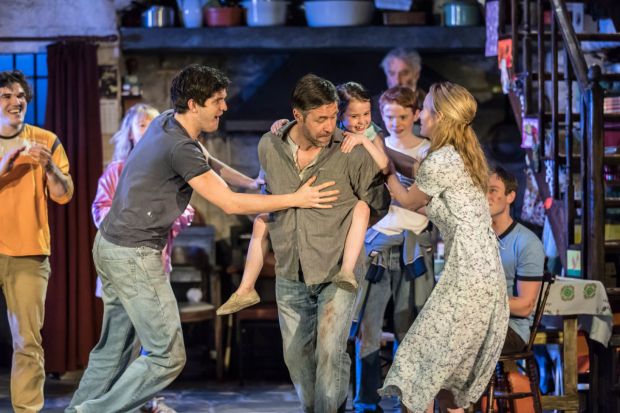Theatre is experiencing a golden age of ensemble acting
Shows such as ”The Ferryman” and ”Angels in America” demonstrate how theatre can soar when an entire cast works together, says Sarah Crompton

© Johan Persson
I feel I am living through a glorious period of ensemble acting in my theatrical outings at the moment. In show after show, I want to write the name of every member of the cast in my review.
Look at Jez Butterworth’s The Ferryman – 21 people in the cast and every one of them (even the baby) pulling their weight, surrounding a powerful central performance by Paddy Considine with vigour and depth, light and shade. Or Angels in America where Nathan Lane and Andrew Garfield may have the showiest parts, but where every single person on the stage works towards a common goal of bringing Tony Kushner‘s sprawling epic to full theatrical life.
The cast doesn’t have to be big for you to feel that unity of purpose. Our Ladies of Perpetual Succour gives six talented actresses scope to express their individuality while simultaneously showing their peers off in the best light. As for Richard Nelson’s Gabriels trilogy (on for one last glistening weekend at the Brighton Festival and really deserving of being seen more widely) well, it is just a wonder of empathy and communal purpose; all six actors listen so hard to the words being said and say their own with such commitment and naturalism that it is hard to believe they are acting rather than simply living.
The technological trickery of film and TV means that it is possible for a skilled actor to give an entire performance on a green screen
Seeing acting like this is part of what makes theatre so rewarding. When you watch a film, you know that in all likelihood you are – if it is a good film – watching something played between actors. Friends who act in film or on TV always talk with gratitude of other actors who let them play a scene with them, even if they are not in shot.
But that comradely generosity is not universally practised and the technological trickery of film and TV means that not only is it possible for a skilled actor to give an entire performance on a green screen but it is also possible for him or her to film their role with precious little interaction with the rest of the cast. The camera, and through the camera's eye, is the audience that they have to convince.
There is no such luxury in the theatre. Everything is up front and visible. The audience has to respond to the same vibrations as the actors. Sometimes when I am watching a play I am distracted by the sense that although there are good performances going on, there are others that are less convincing or – heaven forfend – trying to catch my attention with their brilliance, rather than lending their shoulder to the general good.
Ensemble acting is a valuable reminder of why live theatre can knock spots off its recorded counterparts
Yet when actors perform as a unit, it is overwhelmingly powerful. Watching Woyzeck at the Old Vic the other night, I was struck by the way that John Boyega‘s relative inexperience as a theatre actor – this tricky part is his first starring role – is bolstered by the incredible strength in depth of the rest of the cast. Their support allowed his talent to shine.
Similarly, when I saw Nina Raine‘s Consent at the National Theatre the other week (and I am keeping my fingers crossed for a transfer), I was impressed by the way that the finesse and skill of each performance meant that your sympathies were constantly tugged in different directions, just as they are by Raine’s subtle, difficult, brilliant writing.
These ad hoc ensembles are not in the same order of instinctive understanding that you might see in the work of the Maly Theatre, or Ariane Mnouchkine’s dazzling Théâtre du Soleil, where the actors have worked together so long that they seem to express a communication beyond words. But they are a valuable reminder of why live theatre can knock spots off its recorded counterparts.
The actors’ commitment and skill charges the space between the characters on stage. Every particle of the air seems to breathe and speak, even when the actors are silent. With acting of this calibre, every production is more than the sum of its parts. It is something to behold.













